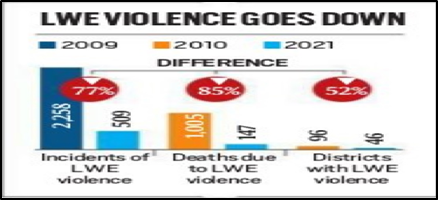In News:
- According the data provided by the Ministry of Home Affairs in Lok Sabha, Left Wing Extremism (LWE) violence has decreased from 2258 in 2009 to 509 in 2021.
What’s in Today’s Article:
- Left Wing Extremism (About, causes for spread, steps taken by the govt)
- News Summary
Left Wing Extremism (LWE)
- Left-wing extremism is the single internal security threat that affects the largest number of States in India.
- LWE aims to overthrow the existing democratic state structure with violence as their primary weapon, and mass mobilization and strategic united fronts as complementary components.
- They plan to usher in So-called ‘New Democratic Revolution’ in India.
- Left-wing extremists are popularly known as Maoists worldwide and as Naxalites in India.
Causes for spread of LWE
- Land Related Factors:
- Encroachment of Government and Community lands (even the water-bodies) by powerful sections of society.
- Lack of title to public land cultivated by the landless poor.
- Poor implementation of laws prohibiting the transfer of tribal land to non-tribals in the Fifth Schedule areas.
- Non-regularisation of traditional land rights.
- Displacement and Forced Evictions:
- Eviction from lands traditionally used by tribals.
- Displacements caused by irrigation and power projects without adequate arrangements for rehabilitation.
- Large scale land acquisition for ‘public purposes’ without appropriate compensation or rehabilitation.
- Livelihood Related Causes:
- Lack of food security – corruption in the Public Distribution System
- Disruption of traditional occupations and lack of alternative work opportunities.
- Deprivation of traditional rights in common property resources.
- Social Exclusion:
- Denial of dignity.
- Continued practice, in some areas, of untouchability in various forms.
- Poor implementation of special laws on prevention of atrocities, protection of civil rights and the abolition of bonded labour etc.
- Governance Related Factors:
- Corruption and inadequate provision/non-provision of essential public services including primary health care and education.
- Misuse of powers by the police and violations of the norms of law.
- Unsatisfactory working of local government institutions.
Steps Taken by the Govt.
- Though primarily a State subject, MHA has promulgated a ‘National Policy and Action Plan’ since 2015 to address the menace of LWE.
- The significant features of the policy are zero tolerance towards violence coupled with a big push to developmental activities.
- MHA is supporting the State Governments for Capacity Building and strengthening of Security Apparatus by deployment of CAPF Battalions, provision of helicopters and UAVs etc.
- Funds are also provided for modernization and training of State Police under
- Modernization of Police Force (MPF),
- Security Related Expenditure (SRE) Scheme and
- Special Infrastructure Scheme (SIS).
- For development of LWE Affected States, Government has taken several developmental initiatives which include
- sanction of 17,600 kms of road
- installation of mobile tower in LWE affected districts
- financial inclusion through opening of banks, ATMs etc.
- imparting quality education to the youth with special focus on opening of Eklavya Model Residential Schools
- a total of 234 EMRSs have been sanctioned for LWE affected districts, of these 119 are functional
- Under Special Central Assistance (SCA) Scheme for further impetus to development in the most affected districts, more than 10000 projects have been taken.
Sub-categorization of districts
- MHA had categorized certain districts as LWE affected and covered under Security Related Expenditure (SRE) Scheme.
- Of these SRE districts, the districts accounting for more than 85% of country-wide LWE violence are categorized as ‘Most Affected Districts’.
- This is done for focused deployment of resources - both security and development related.
- Few new areas have been identified as potential locations for emergence of this phenomenon.
- To arrest the expansion and also to restrict them to bounce back in the areas recently taken away from LWE influence, 08 districts have been categorized as ‘District of Concern’.
News Summary
- While replying to a question in Lok Sabha, MHA said that incidents of Naxal violence have dropped by 77% between 2009 and 2021.
Key Highlights:

- LWE violence decreased from 2258 in 2009 to 509 in 2021.
- Resultant deaths (civilians and security forces) due to LWE violence have reduced by 85% from an all-time high of 1005 in 2010 to 147 in 2021.
- Stat-wise and year-wise data on death of security forces between 2019 and 2022 shows that the LWE problem continues to rage in Chhattisgarh.
- While 22 security force personnel were killed in Naxal violence in Chhattisgarh in 2019, as many as 45 were killed in 2021.
- In 2021, Chhattisgarh accounted for 90% of all security personnel deaths in the country.
- Jharkhand is the only state that recorded security personnel deaths (5) after Chhattisgarh in 2021.
- Geographical spread of the violence has reduced as only 46 districts reported LWE related violence in 2021 as compared to 96 districts in 2010.
- Decline in geographical spread is also reflected in reduced number of districts covered under Security Related Expenditure (SRE) scheme.
- The number of SRE districts was also reduced from 126 to 90 in April 2018 and further to 70 in July 2021.
- Most LWE Affected Districts – defined as districts contributing approximately 90% of LWE violence – came down to 30 from 35 in 2018 and further to 25 in 2021.









